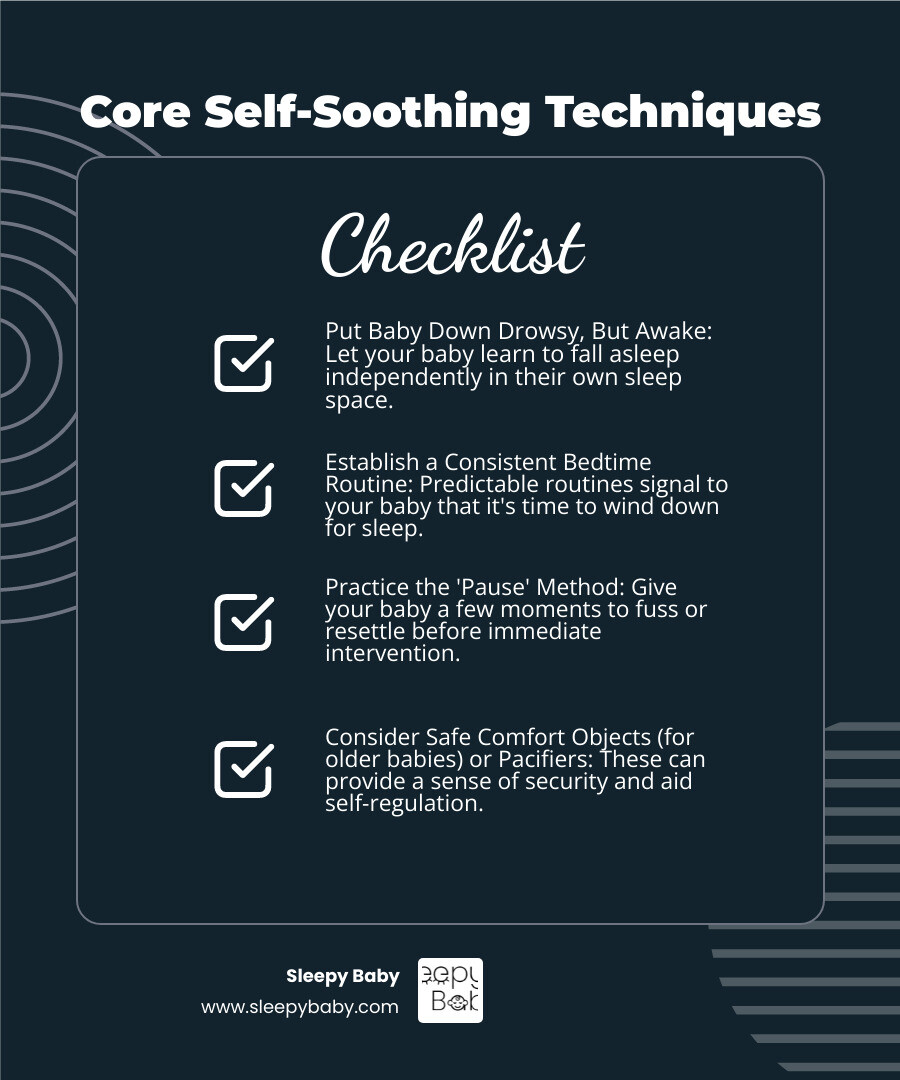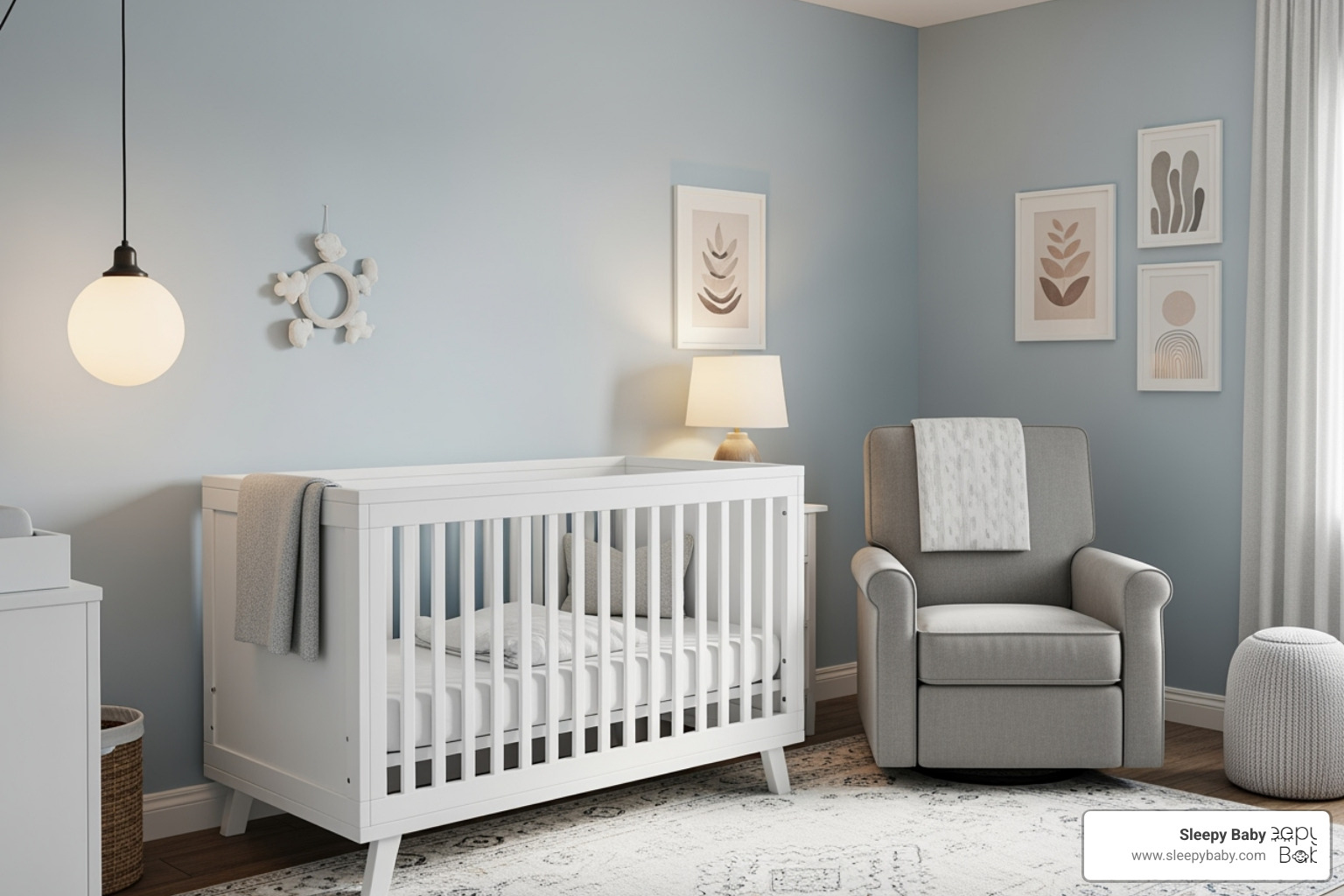The Journey to Independent Sleep: Understanding Self-Soothing Baby Techniques
If you're reading this, you're likely navigating the universal new-parent challenge of sleepless nights. It's true: babies from birth to 12 months typically wake up between one and three times per night. In fact, over 50% of parents struggle to get a full night's sleep until their child is three years old. But there's good news. Learning self soothing baby techniques can transform your nights and bring much-needed rest to your family.
These techniques help your baby learn to calm themselves down and fall asleep independently. Here are some core strategies you'll learn to encourage self-soothing:
- Put Your Baby Down Drowsy, But Awake: Help your baby learn to fall asleep in their own sleep space, rather than in your arms.
- Establish a Consistent Bedtime Routine: Predictable routines signal to your baby that it's time to wind down for sleep.
- Practice the "Pause" Method: Give your baby a few moments to fuss or resettle before you immediately intervene.
- Consider Safe Comfort Objects (for older babies) or Pacifiers: These can provide a sense of security and help with self-regulation.
Teaching your baby to self-soothe is a journey, not a quick fix. It's about empowering your little one with a lifelong skill that benefits everyone in the family.
At Sleepy Baby, we understand these struggles firsthand. Our journey into creating solutions for self soothing baby techniques began out of a personal need to help our own children find peaceful sleep.

What is Self-Soothing and Why is it a Game-Changer?
Picture this: your baby stirs in their crib, makes a few soft sounds, and then settles back into peaceful sleep—all without you rushing in to help. This is the magic of self soothing baby techniques in action, and it's truly a game-changer for families.
When we talk about self-soothing, we're describing your baby's ability to calm themselves down, regulate their emotions, and return to a settled state. It's much more than just a sleep trick—it's a fundamental life skill that impacts emotional regulation throughout their entire life. As child development experts explain, "Self-soothing is a way of regulating your emotions." Just like learning to smile, crawl, or walk, it's a developmental milestone that unfolds naturally with the right support.
For parents, this skill means less reliance on constant intervention and more consistent sleep for the whole family. For babies, it fosters a deep sense of security and competence, helping them steer their world with greater confidence and ease. You can learn more about how we help babies develop this crucial ability at Self-Soothing: Help Your Baby Learn This Life Skill and explore The Art of Self-Calming: Helping Infants Find Their Zen.
The Difference Between Self-Soothing and Self-Settling
Here's something that confuses many parents: self-soothing and self-settling are related but distinct skills. Think of self-soothing as the emotional foundation and self-settling as the sleep application of that foundation.
| Feature | Self-Soothing | Self-Settling |
|---|---|---|
| What is it? | A baby's ability to calm themselves down, regulate their emotions, and return to a settled state. This is an emotional skill. | A baby's ability to fall asleep independently (or return to sleep) without needing external help (e.g., rocking, feeding, patting). This is a sleep skill. |
| How do they do it? | Sucking fingers/thumb, holding a comfort object, humming, rocking self, rubbing face/ear. | By learning to transition from a state of wakefulness to sleep in their own sleep space. |
| Why is it important? | Fosters emotional resilience, self-regulation, and coping mechanisms. It's a foundational skill for independent sleep. | Promotes independent sleep habits, longer stretches of sleep, and reduces reliance on parental intervention for sleep initiation. |
| Parental Role | We help by providing a consistent, supportive environment where they can practice these skills. This is often called "co-regulation" – we set them up for success. | We help by creating a conducive sleep environment and putting them down "drowsy but awake." |
| Outcome | Baby learns to soothe themselves when distressed, not just for sleep. | Baby learns to fall asleep and back to sleep on their own. |
Understanding this distinction helps you tailor your approach more effectively. You're not just trying to get your baby to sleep—you're teaching them vital life skills that will serve them well beyond infancy. Self-soothing is the emotional regulation that makes self-settling possible, and both work together to create confident, capable little ones.
Key Benefits for Your Baby's Development
The benefits of teaching self soothing baby techniques extend far beyond those precious full nights of sleep (though we certainly won't complain about those!). For your little one, these skills build a strong foundation for emotional and physical well-being that lasts a lifetime.
Improved sleep quality and duration is often the first benefit parents notice. Babies who can self-soothe tend to sleep for longer periods and enjoy more total sleep time at night. This isn't just convenient for exhausted parents—it's crucial for your baby's rapid brain development and physical growth.
Emotional resilience develops as babies learn to calm themselves. These early coping mechanisms translate into better emotional regulation as toddlers and beyond, helping them manage frustrations and steer challenges with greater ease. Think of it as giving your child an emotional toolkit they'll use throughout their life.
Increased confidence blooms when babies successfully self-soothe. Each time they manage to calm themselves or fall asleep independently, they build trust in their own abilities. This sense of competence becomes a cornerstone of their developing self-esteem.
Reduced fussiness is another welcome benefit. A baby who has tools to manage their own discomfort is often a happier, more content baby overall. They're less likely to become overwhelmed by everyday stresses because they have strategies to cope.
As pediatric experts wisely remind us, "Learning emotional control is a process that takes years, so don't expect too much from an infant or toddler." This gentle reminder helps us approach self soothing baby techniques with patience and realistic expectations, knowing that we're nurturing a gradual but incredibly valuable developmental journey.
The Self-Soothing Timeline: When and How Do Babies Learn?
Here's something that might surprise you: babies aren't born knowing how to self-soothe. It's actually a developmental milestone that unfolds gradually, just like learning to smile or roll over. Understanding when this happens can save you from unnecessary worry and help you introduce self soothing baby techniques at just the right time.

Most babies begin developing self-soothing abilities around 4 to 5 months old. This timing isn't random – it coincides with their circadian rhythm finally maturing, which helps regulate their natural sleep-wake cycles. By 6 months, most little ones can go 8 or more hours without needing a nighttime feed, making this an ideal window for encouraging independent sleep skills.
There's another reason this timing matters: separation anxiety typically kicks in around 8 to 9 months. Teaching self soothing baby techniques before this developmental phase can make the process smoother for everyone involved.
Can Newborns (0-3 Months) Self-Soothe?
The short answer is no, and that's completely normal. Newborns are essentially still adjusting to life outside the womb during what many call the "fourth trimester." They're completely dependent on you for comfort and emotional regulation.
During these first three months, your baby doesn't develop habits or expectations around sleep. This means you literally cannot spoil a newborn by responding to their cries or helping them fall asleep. They need your physical and emotional support to settle back to sleep.
As pediatricians explain, "Newborns need you to help soothe them because they don't have the ability to control their emotions." So go ahead and cuddle away – you're doing exactly what your baby needs! For more insights on comforting your youngest infant, check out The Calming Chronicles: Helping Your Infant Self-Soothe.
Recognizing Natural Self-Soothing Behaviors
Even before babies can fully self-soothe, they'll give you glimpses of their natural ability to comfort themselves. These behaviors often start as involuntary movements but can develop into intentional self soothing baby techniques with your encouragement.
Hand-sucking or thumb-sucking is perhaps the most classic sign. Many babies find incredible comfort in sucking on their fingers, hands, or thumbs. This oral stimulation is naturally calming and one of their first tools for self-regulation.

You might also notice your baby bringing their hands to midline – gathering their hands together or to their chest, especially when swaddled with hands near their face. This provides a sense of security and control that's deeply comforting.
Gentle head rocking is another common behavior. Some babies will subtly rock their heads from side to side against the mattress, finding comfort in this rhythmic motion. Similarly, leg thumping or kicking might look like fussiness, but many babies actually find comfort in rhythmically moving their legs against the mattress.
As they get a little older, listen for murmuring or humming sounds. Some babies make soft cooing, murmuring, or humming sounds as they drift off to sleep or resettle themselves.
These early behaviors are your baby's first attempts at self-regulation. Your role is to create a safe, supportive environment where they feel secure enough to explore and develop these budding skills into reliable self soothing baby techniques.
Your How-To Guide to Gentle Self-Soothing Baby Techniques
Self-soothing blossoms through short, repeatable moments, not one dramatic night of "sleep training." Think consistency, not intensity.
Foundational Soothing: The 5 S's for Newborns (0-3 Months)
Dr. Harvey Karp's 5 S's recreate womb-like comfort when little ones are too young to calm themselves:
- Swaddling – snug but hip-safe wrapping prevents startling.
- Side/Stomach hold – for calming only, never for sleep.
- Shushing – your steady "shhh" or white-noise machine mimics uterine whooshing.
- Swinging – gentle, head-supported rocking. (Never shake.)
- Sucking – pacifier, clean finger, or their own hands trigger a relaxing reflex.
Use one or two S's at a time; too many can overwhelm.
Step-by-Step Guide for Babies 4-6 Months & Up
- Drowsy but Awake – the golden rule. Lay baby down when eyes are heavy, not closed.
- The Pause – wait 1–2 minutes before intervening with light fussing, gradually extending the pause to 5–10 minutes.
- Gradual Withdrawal (Fading) – lessen the help you give bit by bit; rock to drowsy today, just a reassuring hand tomorrow, stand by the door next week.
- Rhythmic Patting – soft, even pats on back or bottom copy your heartbeat and work beautifully with Sleepy Baby’s rhythmic-patting aids.
- Comfort Object (6 + Months) – a small, breathable lovey or Sleepy Baby comforter offers familiar reassurance. Introduce only once baby can roll and remove items independently.
Common Pitfalls to Dodge
- Rushing In – fussing is practice, not a problem.
- Inconsistency – pick an approach and stick with it for at least a week.
- Over-Stimulating – limit tricks to one or two calming inputs.
- Sleep Props – avoid habits that need recreating every 90 minutes overnight.
- Comparisons – your baby’s timeline is the right timeline.
- Missing Tired Cues – an overtired baby finds self-soothing almost impossible.
Creating the Perfect Sleep Oasis & Troubleshooting
A calm nursery is the launchpad for every self-soothing success.

Safe, Simple, Sleepy
- Back to sleep on a firm, flat mattress; no loose items. See the research on back sleeping and SIDS.
- Room temp: 68-72 °F / 20-22 °C.
- Keep it dark and quiet; a white-noise machine masks household sounds.
The Power of Routine
Bath, PJs, cuddle, a short book, and dimming the lights—done in the same order nightly—cues the brain that sleep is next. Add soft lullabies or the hum of a Sleepy Baby sound machine for an extra layer of calm. For ideas, read Baby Got Bach: Soothing Sounds for Babies to Drift Off.
Troubleshooting Quick Guide
- Sleep regression – stay consistent; it passes in 1-3 weeks.
- Illness/teething – comfort first, training later.
- Persistent crying – check basics (hunger, diaper, temperature). If cries remain intense or last >3 hours a day, talk to your pediatrician. You can find a pediatrician easily online.
- Parental overwhelm – it’s okay to pick baby up, reset, and try again next nap.
- More help for excessive fussiness: Colic Conundrum: How to Soothe Your Baby.
Frequently Asked Questions about Teaching Self-Soothing
How long does it take?
With developmental readiness (around 4–6 months) and daily consistency, most families notice clear progress within 7–14 days. Some babies need more time—that’s normal.
Is a little crying okay?
Brief fussing while baby tries to resettle is acceptable. The moment it escalates to distressed crying, check needs and offer calm reassurance. This responsive approach is not the same as long-form "Cry It Out."
What about pacifiers?
Pacifiers are terrific early self-soothers and may reduce SIDS risk. Worry about weaning only if baby wakes repeatedly for lost pacis after 6 months. Tips and alternatives: Calm and Collected: Popular Self-Calming Tools for Infants.
Conclusion
Teaching your little one self soothing baby techniques is truly one of the most wonderful gifts you can share with them – and with yourself! We know those early days of parenthood can feel like a blur of sleepless nights, but finding how to help your baby find their own calm can be a game-changer. It’s a journey that asks for your patience, gentle consistency, and a loving understanding of your baby's unique pace. It's a marathon, not a sprint, and every step forward is a victory.
Throughout this guide, we've explored what self-soothing truly means, the subtle but important difference from self-settling, and when babies are typically ready to learn these incredible skills. We dove into practical strategies that you can start using today: from the foundational 5 S's that comfort newborns, to the "drowsy but awake" method and the gentle Pause technique for our slightly older infants. We talked about fostering those natural self-soothing behaviors like hand-sucking, creating that perfect, peaceful sleep oasis, and sticking to a consistent bedtime routine that signals it’s time to wind down. And just as importantly, we highlighted common little mistakes to sidestep, like rushing in too quickly or accidentally creating sleep props.
Most importantly, always trust that deep parental intuition you have. It will guide you on when to offer comfort and when to give your little one space to practice. And please, never hesitate to reach out for professional help if you're feeling overwhelmed or have concerns.
This journey isn't just about achieving more precious sleep (though that's a fantastic bonus!); it’s about empowering your little one with a lifelong skill of emotional regulation and independent thinking. It’s about building their confidence and resilience from the very start. At Sleepy Baby, we're here to walk alongside you on this path, offering helpful tools to support your family's sleep journey. Our portable, intelligent sleep aids are designed to mimic your comforting touch, featuring rhythmic patting and soothing white noise to encourage better, independent sleep. These hands-free, customizable solutions are crafted to support caregivers like you across Australia, Austria, Belgium, Canada, Czechia, Denmark, Finland, France, Germany, Hong Kong SAR, Ireland, Israel, Italy, Japan, Malaysia, Netherlands, New Zealand, Norway, Poland, Portugal, Singapore, South Korea, Spain, Sweden, Switzerland, United Arab Emirates, United Kingdom, and the United States.
You are doing an absolutely amazing job. Keep going, and soon, your family will be enjoying the peaceful nights you've been dreaming of. For even more insights and solutions to help your baby sleep soundly, be sure to check out The Ultimate Guide to Baby Sleep Solutions: No More Fights!.



